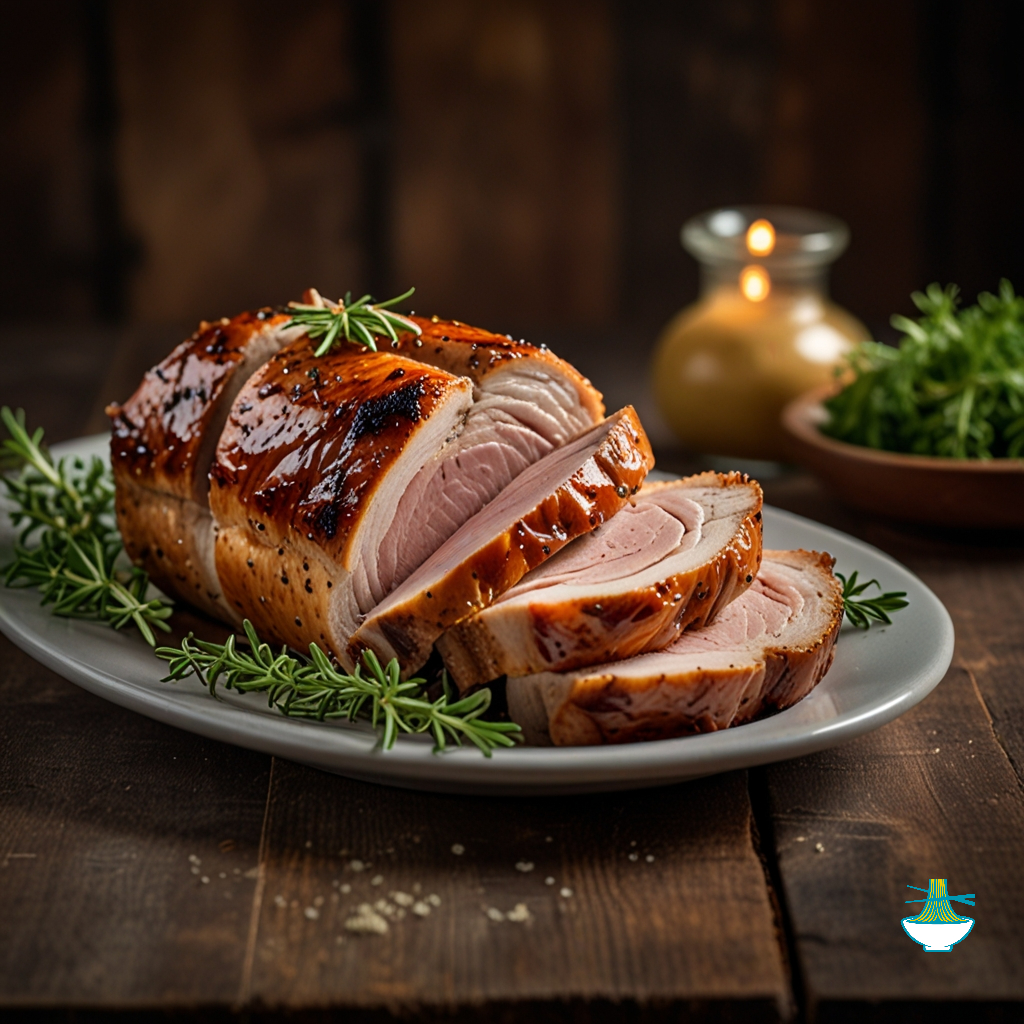Porchetta is a traditional Italian dish that features roast pork seasoned with a blend of herbs and spices, such as rosemary, garlic, fennel seeds, and black pepper. The pork is typically rolled and slow-roasted until tender and flavorful, creating a crispy exterior and succulent interior. 
This dish has ancient origins, dating back to Roman times when it was prepared for festive occasions and celebrations. Originally, porchetta was made with whole pigs, seasoned with wild herbs and slow-cooked over wood fires. Over time, the recipe evolved into the modern version we know today, where pork belly or loin is often used, offering a rich and aromatic experience.
Porchetta is popular throughout Italy, with regional variations in seasoning and preparation methods. It is often served as slices on its own or in sandwiches, making it a beloved street food and a highlight of Italian culinary traditions.
Ingredients:
- 4-5 pounds pork belly or loin, skin on
- 4 cloves garlic, minced
- 2 tablespoons fresh rosemary, chopped
- 2 tablespoons fennel seeds, crushed
- 1 tablespoon black pepper, freshly ground
- 2 teaspoons salt
- 2 tablespoons olive oil
Method of Preparation:
1. Preheat your oven to 325°F (165°C).
2. Score the pork skin in a diamond pattern, being careful not to cut into the meat.
3. In a bowl, mix together the minced garlic, chopped rosemary, crushed fennel seeds, black pepper, salt, and olive oil to create a paste.
4. Rub the paste all over the pork, ensuring it gets into the scores on the skin.
5. Roll the pork tightly and tie it with kitchen twine to hold its shape.
6. Place the pork on a roasting rack in a roasting pan, with the skin side up.
7. Roast in the preheated oven for about 3-4 hours or until the internal temperature reaches 160°F (71°C) and the skin is crispy.
8. Let the porchetta rest for 15-20 minutes before slicing and serving as desired, either on its own or in sandwiches.
Nutrition Value:
1. Pork Belly or Loin (4-5 pounds, skin on):
- Calories: Approximately 230 calories per 100 grams (varies based on cut and fat content).
- Carbohydrates: Negligible, less than 1 gram per serving.
- Protein: About 20-25 grams per 100 grams, depending on the cut.
- Fat: High in fat, primarily saturated fat, providing energy and flavor.
- Sodium: Typically low in sodium naturally.
- Cholesterol: Moderate to high cholesterol content, especially in pork belly.
- Vitamins: Contains B vitamins (B6, B12), niacin, and small amounts of vitamin D.
- Minerals: Provides essential minerals like zinc, phosphorus, and selenium.
- Nutritional Benefit: Pork is a good source of protein and essential nutrients, but moderation is key due to its fat and cholesterol content.
2. Garlic (4 cloves, minced):
- Calories: About 4 calories per clove.
- Carbohydrates: Around 1 gram per clove.
- Protein: Minimal, less than 1 gram per clove.
- Fat: Very low fat content.
- Sodium: Low in sodium naturally.
- Cholesterol: No cholesterol.
- Vitamins: Rich in vitamin C, vitamin B6, and manganese.
- Minerals: Contains trace amounts of calcium, potassium, and phosphorus.
- Nutritional Benefit: Garlic is known for its antioxidant properties, supports heart health, and may have immune-boosting effects.
3. Fresh Rosemary (2 tablespoons, chopped):
- Calories: Approximately 2 calories per tablespoon.
- Carbohydrates: Less than 1 gram per tablespoon.
- Protein: Minimal, less than 1 gram per tablespoon.
- Fat: Very low fat content.
- Sodium: Low in sodium naturally.
- Cholesterol: No cholesterol.
- Vitamins: Contains vitamin C, vitamin A, and small amounts of vitamin B6.
- Minerals: Provides iron, calcium, and potassium.
- Nutritional Benefit: Rosemary is rich in antioxidants and may have anti-inflammatory properties, supporting digestive health and immunity.
4. Fennel Seeds (2 tablespoons, crushed):
- Calories: About 12 calories per tablespoon.
- Carbohydrates: Around 2 grams per tablespoon.
- Protein: About 0.5 grams per tablespoon.
- Fat: Minimal fat content.
- Sodium: Low in sodium naturally.
- Cholesterol: No cholesterol.
- Vitamins: Contains vitamin C, vitamin A, and small amounts of vitamin B6.
- Minerals: Provides calcium, magnesium, and potassium.
- Nutritional Benefit: Fennel seeds are rich in fiber, support digestive health, and may have antioxidant properties.
5. Black Pepper (1 tablespoon, freshly ground):
- Calories: About 15 calories per tablespoon.
- Carbohydrates: Around 4 grams per tablespoon.
- Protein: About 1 gram per tablespoon.
- Fat: Minimal fat content.
- Sodium: Low in sodium naturally.
- Cholesterol: No cholesterol.
- Vitamins: Contains vitamin K, vitamin C, and small amounts of vitamin A.
- Minerals: Provides manganese, iron, and calcium.
- Nutritional Benefit: Black pepper aids digestion, may improve nutrient absorption, and has potential anti-inflammatory effects.
6. Salt (2 teaspoons):
- Calories: Negligible (approximately 0 calories).
- Carbohydrates: None.
- Protein: None.
- Fat: None.
- Sodium: High sodium content; 1 teaspoon of salt contains about 2,300 milligrams of sodium.
- Cholesterol: None.
- Vitamins: No significant vitamin content.
- Minerals: Provides essential sodium for electrolyte balance.
- Nutritional Benefit: Salt is necessary for flavor enhancement and maintaining fluid balance but should be used in moderation due to its high sodium content.
7. Olive Oil (2 tablespoons):
- Calories: Around 120 calories per tablespoon.
- Carbohydrates: None.
- Protein: None.
- Fat: Healthy monounsaturated fats.
- Sodium: Naturally low in sodium.
- Cholesterol: No cholesterol.
- Vitamins: Contains vitamin E and vitamin K.
- Minerals: Provides small amounts of iron and calcium.
- Nutritional Benefit: Olive oil is rich in antioxidants, supports heart health, and may have anti-inflammatory effects. It's a healthier alternative to saturated fats like butter.


Comments